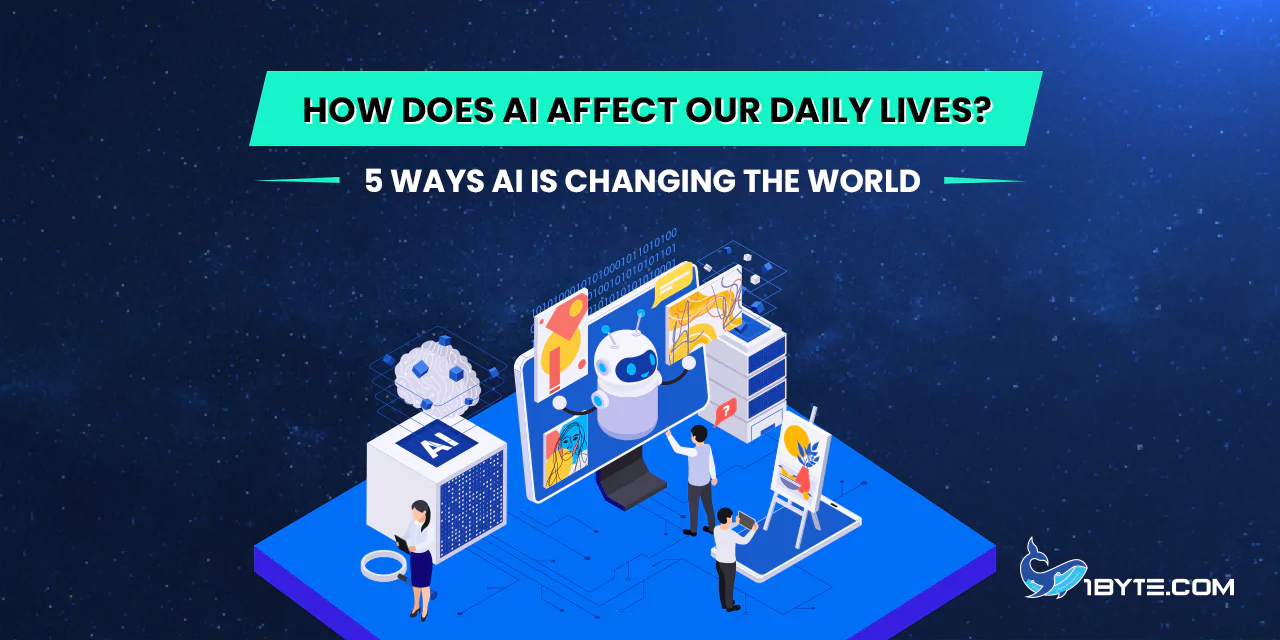Artificial intelligence (AI) has been effortlessly weaved into our day to day activity (perhaps sometimes without us thinking we are doing so). As AI continues to evolve, its influence on our daily lives becomes increasingly profound. Understanding the answer to the question “how does AI affect our daily lives” enables us to navigate its benefits and challenges more effectively, ensuring that we harness its potential while remaining mindful of ethical and practical considerations. Read this article from 1Byte to find out more.
Overview of AI’s Rapid Integration into Everyday Routines
Artificial intelligence (AI) has played an important part in people’s lives and that of their interaction with technology, in doing tasks they normally perform. 34% of consumers recently expressed that they are open to allowing AI assistants to make purchases on their behalf, a sign that consumers are trusting AI for making decisions . This shows how AI seamlessly is making its way in the daily life.
AI is accelerating adoption in the workplace. A report by McKinsey suggests that within the next year 47% of employees expect they will use generative AI to do more than 30% of their daily tasks. Such a trend presents AI’s growing involvement in the professional world.

Virtual assistants like Siri, Alexa and Google Assistant that use AI have become commonplace. It provides these users with tools to manage schedules, control smart home devices, access information through voice commands and more. Their widespread use showcases AI’s integration into daily routines.
Google Maps and Waze utilize AI to examine real time traffic data and suggest to the users the right route and the estimated time of arrival. It also demonstrates how AI is changing day to day transportation.
AI based recommendation systems in the world of online shopping analyzes the user behavior and suggest the product as per their preference. The personalisation involved seals the shopping experience and shows that AI has an influence on consumer habits.
AI is used for filtering the spam and detecting the phishing attempts as email services take advantage of it in order to secure communication. Apart from that, AI can also help in grammar and spelling errors in messages with its utilization of AI grammar and spell tools which enables AI to integrate AI in daily routines.
AI enabled ovens and washing machines are smart home devices that watch user habits and offer cooking programs recommendations or optimize the cycles based on the user’s habits. Then there are the innovations that make cleaning the house and other mundane chores much simpler, a clear way in which AI can be used to improve your life at home .
Today, one can find artificial intelligence being integrated in a lot of places in our daily routines and indeed drawing more joy. Because AI is still maturing, it can be anticipated that its impact can grow on people’s everyday lives, especially how they manage their personal and work lives.
5 Specific Ways AI Affects Our Daily Lives
More and more individuals are witnessing the introduction of artificial intelligence into their daily lives without recognizing its presence. According to recently released findings, 64% of U.S. adults correctly responded that AI is behind custom product recommendations during online shopping. This points to increasing sense of AI’s role in day to day activities.
Smart Assistants and Voice Commands

Smart assistants, like Siri, Alexa, and Google Assistant, have successfully incorporated artificial intelligence (AI) into daily life. The output is these AI driven tools can do work through voice commands, making the use more convenient and efficient. The people, for example, set reminders, play music or move smart home devices simply through speech. This is just one example of AI influencing our daily lives, as millions of people have started to adopt voice activated assistants.
Increasing Adoption and Usage
Usage of voice assistants has exploded. According to data, 142 million people in the US were voice assistant users in 2022 which will rise further and surpass the mark of over 157 million by 2026. By 2024, the number of digital voice assistants in use is expected to reach 8.4 billion units globally, surpassing the number of people on Earth. This is an indication of a much greater movement towards the adoption of voice activated technology in people’s daily lives.
Enhancing Daily Tasks
In this, we find smart assistants or assistants that are becoming irreplaceable for managing the everyday things that we undertake. They help set alarm, offer weather updates, and answer questions, thus aiding one to organize a daily schedule. For example, a user can ask their assistant about the traffic conditions before they take on a commute to plan better. This shows how artificial intelligence influences our life on a daily basis by executing simple tasks.
Impact on Consumer Behavior
They also impacted consumer behavior. About 24 percent of smartphone voice users are ordering food using voice search and 38 percent using voice search to search for businesses near them. In addition, 40 percent of users reported that they would buy a product after an (audible) voice advertisement. Hence this trend traces the increasing confidence in commands or transactions through AI driven recommendations.
Improving Accessibility
Voice assistants are great for people with disabilities or immobility. A hands free way of interacting with technology using which a user can send messages, control home appliances or get information without using physical interaction. This inclusivity for the good of all of us goes to show that we all can get involved with AI in our day to day lives by making Tech easier to reach.
Challenges and Considerations
Although smart assistants are seen as desirable, they pose some challenges. Continuous listening capabilities of these devices raise privacy concerns because they could be potential data security issues. Furthermore, voice recognition inaccuracies can lead to misinterpretations or task errors. When integrating AI into users’ daily routine, these factors have to be weighed.
Thus smart assistants and voice commands have recently made a significant impact on personal tasks and information management, as well as shopping. The integration of AI in everyday life is still evolving and it is bringing benefits and also some concerns for the users.
Personalized Recommendations
Artificial intelligence (AI), namely, has revolutionized the way we all are being recommended, in a personalized way, everyday. The analysis of the data of the user allows AI to create personalized suggestions on the different platforms to create a better user experience and user engagement. This is how an AI dirty work is affecting our lives without us noticing it even on the daily basis.
E-Commerce Personalization
When it comes to online retail, AI powered recommendation systems help in making recommendations to online retailers based on browsing and purchase history, about products that are most suited for individual preferences. For instance, Amazon’s AI algorithms personalize product recommendations, which in turn leads to more purchase and thus ensures a better shopping experience.
Fashion Industry Innovations
AI is also being used by the fashion sector to come up with style suggestions customized to the user. Algorithms used in services like Stitch fix help to understand the user preferences and show clothing recommendations to the users similar to those done by a personal stylist.
Travel Planning Enhancements
Thanks to AI, travel planning has moved on from suggesting generic destinations and generic itineraries. With AI travel apps, destinations, places to visit, where to stay, what to do and how to plan are just a suggestion away — and much, much easier.
Consumer Attitudes Toward AI Personalization
Different generations have varying degrees of consumer support for AI driven personalization. Percent of Gen Z adults in the U.S. who supported brands that used AI for personalized recommendations as of March 2024 was approximately 55%. The support was 67 percent among millennials and 54 percent among Gen Xers.
Market Growth and Business Adoption
The market that is powering the rapid growth of the AI driven personalized recommendations stands out. The market was valued to be valued at USD 1.84 billion by 2024, and is expected to grow at a CAGR of 29.70% during the forecast period, to reach USD 24.8 billion by 2034.
Additionally, a survey reported how more than 70 percent of brands see allowing for the adoption of AI as central to shifting the business approach to customer engagement by offering personalization and marketing.
To be concise, AI powered personal recommendations have become an essential part of many aspects of modern life and have become especially important in shopping, fashion, traveling, etc. The significance of AI in our everyday lives is demonstrated by this AI integration in enhancing experiences and altering consumer behaviors.
AI in Online Shopping
Online shopping is one area that has dramatically been touched by artificial intelligence (AI). AI is actively integrated into e commerce platforms, which gives the ability to create personalized recommendations, optimize price, and etc — which shows how AI changes our life in the modern world.
Personalized Product Recommendations
AI algorithms that study the users behavior for example the browsing history and the purchase patterns can offer product suggestions based on the user’s own taste. This personalization increases customer engagement and sales. Again, Amazon’s ‘Interests’ AI shopping tool bills new products at consumers and matches them to specific interests depending on the everyday language input in the store.
Enhanced Customer Service with AI Chatbots
Today, chatbots have made a huge mark in the field of customer service in online shopping using AI. Virtual assistants answer queries, help with purchasing of products and provide information about products through the aircraft, available 24/7. In the 2024 holiday session, U.S. websites saw a 42% boost in chatbot usage when contrasted with the earlier year, making AI an essential part of buying assistance.
Pricing Optimization
AI helps retailers in dynamic pricing approaches by assessing the market fads, opposing prices, and need disconnects. It allows businesses to change the prices in real time to make the most of profitability while maintaining competitiveness. E-commerce platforms seeking to achieve the most profitable possible balance between customer satisfaction and profitability, have adopted AI price optimization to become a critical tool.
Visual Search and Image Recognition
Consumers can use AI powered visual search by uploading images of what they are looking for, and get products similar to them online. Image recognition technology used on platforms such as Pinterest and Google Lens matches user uploaded photos with product listing which further simplifies the search process and keeps their users engaged.
Fraud Detection and Security
Online shopping becomes more secure through the use of AI by detecting fraudulent activities in real time. The same thing is used by companies like PayPal and Stripe to process payments, and they use AI algorithms to filter out anomalous transactions which significantly reduces their fraud rate. This way allows for a safer shopping environment for the consumer.
Market Growth and Consumer Adoption
The growth rate of the AI enabled e-commerce market is high. According to a press release, evolve24 is expected to reach $22.60 billion by 2032 with a compound annual growth rate (CAGR) of 14.60 percent and valued at $8.65 billion in 2025. Overall, according to a 2024 survey in the U.S., 52 percent of online shoppers were likely to use generative AI tools to facilitate their online shopping for apparel, a sign of the rising favor with e-commerce shoppers toward AI.
Finally, it can be summarized that the fusion of AI into online shopping has completely evolved the e-commerce arena, paving the way for bespoke experiences, better client service, value, and security. This shows how AI is already present in our lives and is being used to help online shopping become more efficient and user friendly.
Social Media Algorithms

Interactions and information consumption on a daily basis, sessions, is presently shaped by artificial intelligence (AI). AI driven algorithms analyze user behavior, preference and engagement patterns and curate personalized feeds to enhance user engagement and increase the time spent on such platforms. This is an example of how everyday life is impacted by AI by shaping online experience according to a person’s own preferences.
Personalized Content Delivery
For example, Facebook, Instagram and Twitter, use AI algorithms to study how users interact with each other; likes, shares, comments and so on. With this data, the platforms can showcase content with alignment to user interests to further enhance the user experience. For example, Facebook prefers to highlight the posts of one’s friends and pages it visits frequently, to display the most relevant content on its news feed.
Influence on User Behavior
AI powered algorithms not only tailor the content but also nudge the user in using typical kinds of content featured within the platform. As these algorithms put posts that are likely to elicit strong reactions first, they may contribute to sensational or divisive content being amplified, impacting what the public is seeing and hearing. For instance, this highlights how AI influences us in our everyday lives, especially where the information we consume and that we share is concerned.
Challenges and Considerations
Although they have various benefits, AI powered social media algorithms also pose a problem. The type of content personalization can result in the creation of ‘echo chambers’, in which individuals mostly interact with viewpoints that confirm their existing beliefs but avoid diverse perspectives. Moreover the misinformation problem is another problem, if algorithms will promote the false or misleading content accidentally because of the attention users give to that particular content. To balance personalization with promotion of accurate and diverse information and address these issues is also required.
To conclude, social media algorithms fueled by AI have a huge effect on the content people see everyday and thus, on how they perceive, behave, and interact. This reflects on matters of how AI affects our day to day existence, in this situation, and most likely, clears a path to navigate the digital landscape productively.
AI-Powered Navigation and Traffic Updates
With the help of artificial intelligence (AI), navigation and traffic management has changed. Analyzing real time data, AI makes plans of routes, minimizes the congestion and additional travel time, thus, providing example of how AI influences our daily life.
Real-Time Traffic Analysis
AI based navigation systems process data from GPS, traffic cameras, user reports in real time and provide real traffic information. For example, services like Waze include users’ reports of incidents like accidents or road blocks to let drivers change their route to avoid it and get a new path while traveling.
Predictive Traffic Patterns
Historical traffic data is used by AI to predict congestion and give the best time for travel. AI equipped in GPS systems can as well advise on the best alternative schedule during seeking to help you avoid peak hours traffic and save time spent in transit.
Public Transit Optimization
AI helps public transportation agencies in improving operational efficiency. With AI, the inventors make smarter route planning and fleet management possible, which saves costs, offers better service. For example, AI can decrease operation cost by 10 ~ 15% by optimizing employment schedules and resource allocation.
Autonomous Vehicles
The development of self-driving cars, which will have safer and more efficient commuting experience is based on the fast growing AI. These use AI equipped sensors and algorithms to move on roads, detect objects and decide driving in real time.
Enhanced GPS Accuracy
Challenges such as urban canyons and signal interference can prove to be a problem for traditional GPS systems. On top of that, AI helps in improving GPS accuracy as it studies tremendous location data to correct errors live, making it more precise and reliable on the navigation aspect.
Impact on Daily Commutes
Integration of AI in navigation has resulted in a real benefit for the commuters. Average travel time reduction of 15% as reported by Google Maps can be achieved through AI powered route optimization.
In summary, AI has greatly facilitated planning and completing daily trips through AI powered navigation and traffic updates. AI continues to improve travel efficiency, travel safety, and provides real time insights, predictive analytics and increased accuracy – a classic example of how AI affects our daily lives.
Leverage 1Byte’s strong cloud computing expertise to boost your business in a big way
1Byte provides complete domain registration services that include dedicated support staff, educated customer care, reasonable costs, as well as a domain price search tool.
Elevate your online security with 1Byte's SSL Service. Unparalleled protection, seamless integration, and peace of mind for your digital journey.
No matter the cloud server package you pick, you can rely on 1Byte for dependability, privacy, security, and a stress-free experience that is essential for successful businesses.
Choosing us as your shared hosting provider allows you to get excellent value for your money while enjoying the same level of quality and functionality as more expensive options.
Through highly flexible programs, 1Byte's cutting-edge cloud hosting gives great solutions to small and medium-sized businesses faster, more securely, and at reduced costs.
Stay ahead of the competition with 1Byte's innovative WordPress hosting services. Our feature-rich plans and unmatched reliability ensure your website stands out and delivers an unforgettable user experience.
As an official AWS Partner, one of our primary responsibilities is to assist businesses in modernizing their operations and make the most of their journeys to the cloud with AWS.
Conclusion
Indeed, artificial intelligence (AI) has perfectly made its way into almost every part of everyday life, changing the way people interact with technology and the world around them. The pervasiveness and impact of AI from personal productivity enhancement to altering consumer behavior shows no sign of abatement.
As AI is on the verge of moving to a new, even deeper level as it becomes more and more of a part of our everyday life, there are both opportunities and challenges. We can learn how AI influences our day to day living and subsequently utilize the benefits while trying to counter the demerits. This dynamic landscape of AI can be managed well by individuals who know how to stay informed and have the capacity to incorporate critical discussion of AI technologies.

